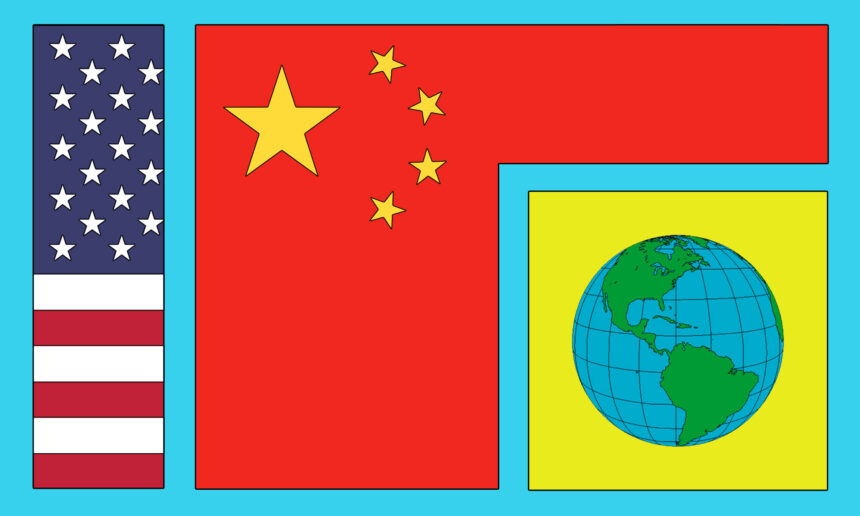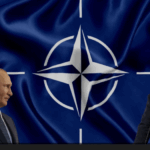Summary by Geopolist | Istanbul Center for Geopolitics:
China’s increasing influence in the Global South is the subject of the essay, which underscores Beijing’s successful portrayal as a champion of emerging states.
The essay explores the ongoing Great Power Competition, now commonly referred to as the “Second Cold War.” This rivalry encompasses three crucial elements:
- Kinetic Front: The potential military conflicts in Ukraine, Israel, and East Asia (with a particular emphasis on Taiwan and the South China Sea).
- Technological Front: The ferocious competition for supremacy in the fields of artificial intelligence, telecommunications, underwater cables, and microchips.
- The Global South is a significant arena for power and influence in the developing world, highlighting the ongoing global rivalry.
Significant investments and diplomatic efforts made by China, particularly through the Belt and Road Initiative (BRI), have produced positive outcomes in a variety of regions, including Africa, Asia, and Latin America.
China has successfully established itself as a significant player in the Global South, strategically framing its engagement as a means of advancing global democratization and challenging the prevailing liberal world order led by the United States. Through programs like the Global Development Initiative (GDI) and its robust presence in telecommunications infrastructure—best demonstrated by Huawei’s 4G networks in Sub-Saharan Africa—China demonstrates its economic clout and soft power.
However, the United States has faced difficulties in offering a convincing alternative. To address this challenge, the United States should consider revising its policy to embrace a proactive and inclusive strategy that aligns with the needs and aspirations of developing nations, instead of depending on techniques reminiscent of the Cold War era.
This involves offering options in crucial areas such as education, military collaboration, telecommunications, and economic advancement. The major objective is to prevent these nations from succumbing to China’s influence and to uphold their commitment to a liberal international system founded on rules.
Read the full article below.
China is Winning the Global South
Great Power Competition, sometimes called the Second Cold War, is unfolding on a global scale. The United States is not competing with the Chinese Communist Party (CCP) in China, nor is the United States competing with Vladimir Putin’s system in Russia. Today, we are competing along a possible “kinetic front” in East Asia (Taiwan and the Nine Dash Line), Ukraine, and Israel. Additionally, there is arguably a “second front” in the realm of technology, encompassing the battle over artificial intelligence, telecommunications, subsea cables, and microchips. Perhaps the most underappreciated yet critical front, a “third front” in this Great Power Competition, is the “Global South,” or the developing world. During the First Cold War, the developing world was a major front, so it is not surprising that the Global South is again a significant theater or—in a scenario where the United States does not end up in a full Great Power War—is the central theater of competition over the next forty years.
The Global South is a notion that comprises many regions, including Africa, Southeast Asia, Latin America, the Pacific Island States, South Asia, Central Asia, some post-Soviet countries, and the Middle East. Historically referred to as the “Third World,” this term is now widely considered to be outdated or even offensive. The “Global South” is a term recently popularized by the CCP—which has spent decades attempting to ingratiate itself within this theater—although the term’s appropriateness is debated. Alternative terms such as the “developing world,” “G-77,” or “new non-aligned countries” have been suggested, though none have proven to be completely satisfactory.
While the United States and allied national security community have focused extensively on the first two fronts—potential military conflicts and technological competition—the third front in the Global South remains critical yet underappreciated. This region represents some of the world’s leading sources of strategic materials, consumer markets, potential allies—as well as current or potential partners in security burden-sharing. China has been actively making inroads in the Global South for well over twenty years, with relationships dating back more than fifty years—some based on Chinese manipulation of anti-colonial sentiments. Russia, in some cases, has relations going back much further, with some lingering, popular appreciation for the Soviet Union’s support during these nations’ anti-colonial struggles.
China views the Global South as a pivotal market and partner in challenging the liberal world order. By leveraging the concerns of the Global South about the current international system, China aims to undermine the influence of the United States. The Chinese leadership, often accusing the United States of initiating a “new cold war,” advocates for the “democratization of international relations.” This narrative is part of China’s broader strategy to reshape the global order around its own interests rather than U.S. ones. Beijing’s asymmetric response emphasizes “non-alignment” and a commitment to helping countries protect their sovereignty, avoiding alignment with major power blocs or external dictates. This approach is presented as a counter to U.S. efforts to restore the appeal of liberal democracy, which China portrays as an outdated “cold war mentality” that threatens Chinese ambitions, both on a regional and global scale.
China’s engagement with the Global South, particularly through initiatives like the Group of Friends of the Global Development Initiative (GDI), underscores its ambition to present itself as a benign provider of international public goods in areas such as poverty alleviation, food security, and digitalization. Over seventy countries have joined the GDI, with over 100 supporting its goals, showcasing China’s role as a development leader. This commitment contrasts with the alleged global protectionism of the United States, which is accused of failing to provide adequate economic support.
Chinese scholars argue that China’s readiness to mobilize the developing world, especially in regions with historical tensions with Western powers, positions it as a critical player in a post-American global order. This strategy is evident in China’s diplomatic stance on issues like Gaza, where it promotes “peace plans” without concrete proposals or direct condemnation of terrorist actions. China’s investment in these regions is part of its vision of “great changes unseen in a century,” emphasizing the growing economic and geopolitical significance of the Global South and its potential to reshape the international landscape.
China is not only a “Near-Peer Hard Power” competitor but also a “Near-Peer Soft Power” competitor. China can now begin to fill any vacuums left by the United States, which it did not have the capacity, power projection capability, or readiness to do just two decades ago. The economic landscape has shifted dramatically. In 1973, China’s economy was worth $138 billion compared to the United States’ $1.43 trillion. By 2023, China’s GDP had soared to nearly $18 trillion, while the United States’ increased to $27 trillion. Despite the United States maintaining a larger economy, China’s 2023 GDP growth rate of 5.2 percent per annum outpaces the United States’ meager 2.5 percent annually. When the West leaves a void, China now has the financial potential to fill it.
The challenge for the United States lies in offering a compelling alternative to China’s pervasive influence. Over the past decade, the United States has sought to discourage the Global South from engaging with Chinese initiatives like Huawei’s telecom solutions, Sinovac vaccines for COVID-19, or the Belt and Road Initiative (BRI)—often without providing a viable alternative. This “strategy,” has left many countries with little choice but to turn to China. We cannot fight something with nothing.
Meeting the aspirations of countries in the Global South with a credible, positive, forward-looking agenda is crucial. Failure to do so will result in these nations increasingly aligning with China, which is not in the United States’ interest.
It would be detrimental to the interests of U.S. interests if every developing country’s largest trading partner were China. If Chinese companies manage their ports, if their elites study in Beijing instead of Boston, and if Huawei or other Chinese technology companies dominate their telecom systems, there will be repercussions for U.S. national security. Developing countries may vote with China and against the United States on vital international issues such as the conflicts in Israel and Ukraine, support Chinese candidates for leadership positions in international organizations, and endorse Chinese-led initiatives in multilateral forums.
The United States must present better value propositions in the Global South to remain relevant. During the Cold War, the United States and the Soviet Union heavily invested in countries in the Global South, motivated by strategic interests and ideological goals. In the 1990s, Peter Rodman’s More Precious than Peace provided a compelling narrative of America’s engagement in the developing world through a Cold War lens, outlining how this competition allowed developing countries to claim a pivotal role in international political questions. American policy faced a twofold challenge at the time: “to guide the underdeveloped regions of the world through a transition to full-fledged participation in the international system and to do so in the face of a Soviet attempt to suborn them as allies in a radical assault on that international system.”
But this is not your grandparents’ developing world. It is more affluent and more free, and their governments enjoy a lot more options. Foreign aid is a very small part of the puzzle, along with private capital, trade, investment, remittance flows, domestic capital, and the ability to raise taxes in a society with much more significant sources of money than fifty years ago. So, the “theory of change” is not necessarily about more foreign aid or the threat of cutting foreign aid off. These countries do not want to be pawns in someone else’s game, nor do they want to be a hegemon’s vassal state.
Since the turn of the century, the developing world has also experienced substantial poverty reduction and progress across a range of social and economic metrics. Most of these countries now also have cell phone penetration rates that are approaching those of the United States. Additionally, these societies are often more free than in the past and boast more active civil societies. The percentage of free countries worldwide has increased from 30 percent in 1973 to 43 percent in 2023.
Hence, over the past thirty-five years, the developing world has prioritized different things than those in the developed world, including the United States. China and sometimes Russia increasingly offer the Global South what these countries actually want, including the development of energy and mineral resources, infrastructure, ports, and, oftentimes, hard security. The United States and the West have to be sure that we are also offering what these countries actually want as opposed to what our political system finds congenial or easy to deliver. The United States should take advantage of its strong international network, including the European Union, Japan, Australia, South Korea, Canada, and Mexico. Such American allies should be able to play a role in formulating a strategy for more proactive engagement.
Certainly, there are fragile and failed states in the Global South that present unique challenges. These fragile and failed states often are sources of mass migration, breeding grounds for terrorism, and areas where sustainable development progress is extremely difficult to achieve. Fragile and failed states are a problem all to themselves and worthy of a longer discussion somewhere else.
However, this does not change the fact that the United States must update its playbook to move beyond the strategies of the Cold War or the immediate post-Cold War era. It must adapt to these new realities in order to participate in the great power competition for the Global South, which is largely non-military. This involves engaging more proactively with the Global South in areas including trade, infrastructure, digital connectivity, education, and economic development.
Telecommunications, in particular, is a key sector. China has become a leading subsea cable provider and owner as part of its “Digital Silk Road.” Chinese state-owned and subsidized firm HMN Technologies (Huawei) is now the fourth-largest cable provider globally and has seen the fastest growth over the past decade, completing over 108 projects. Areas of investment also include emerging critical technology fields such as internet services, where Huawei has provided internet access for hundreds of millions. Today, Huawei subsidiaries own up to 70 percent of all 4G networks in Sub-Saharan Africa.
China’s dominance in telecommunications poses a strategic threat to the United States. Allowing Beijing to control significant digital infrastructure flows increases its influence and potential for surveillance—a reality that has already begun to manifest as China assists despots in the developing world to oppress citizens and dissidents through China’s model of digital authoritarianism. The United States must counter this by increasing investment in digital infrastructure in the Global South, promoting American telecom companies, and offering secure and competitive alternatives to Huawei’s technology.
China has also developed a global network of strategically vital ports under its “Maritime Silk Road”—the oceanic counterpart of the “Digital Silk Road.” Beijing now owns or operates ports and terminals at nearly 100 locations in over fifty countries, spanning every ocean and every continent. The Chinese have ownership in about twenty-three ports in Africa alone. This effectively leaves China in control of ports at the heart of global supply chains, which could be leveraged for geopolitical gain. The United States must respond by investing in port infrastructure projects, offering favorable financing terms, and creating public-private partnerships to support port development in the Global South.
China has dwarfed the United States as Africa’s largest trade partner since 2009. Today, one-fifth of the region’s total goods exports go to China, mainly consisting of raw metals, mineral products, and fuel. The current volume of U.S. trade with African states is only one-fifth the size of trade between Africa and China. To date, fifty-two out of fifty-four African countries have also signed an agreement or understanding with the BRI. China has invested at least two-and-a-half times as much in African infrastructure projects as the entire Western world combined. China’s economic influence through trade and investment creates dependency, potentially leading to political alignment with Beijing. To address this, the United States must boost its economic engagement by increasing trade with African nations and supporting American businesses to enter these markets. Expanding the scope and scale of the Development Finance Corporation’s (DFC) operations and fostering sustainable development partnerships is the first step out of several that would help counterbalance China’s economic clout.
A significant aspect of China’s influence in the Global South also revolves around trade and debt. The DFC committed $9 billion across about 130 transactions last year, while China’s BRI undertook $90 billion across about 210 deals. As a result, many developing countries have become ensnared in Chinese debt traps. This economic dependency translates into political leverage for Beijing. In this new era of great power competition, the United States must reconfigure its foreign aid model to adjust to these realities. This involves rethinking the balance between development loans and grants and preserving open and market-based economies at home and abroad while resisting unfair economic practices. Development aid is not merely a charitable act; it is a strategic investment in future allies. Countries that build their capacities with American support are less likely to fall into Chinese debt traps and more likely to engage in fair and transparent governance.
Another key element of changing global dynamics is where the elites of the Global South choose to study. Higher education remains one of the most effective tools of soft power, fostering good governance, functional and accountable institutions, and an empowered civil society. China’s increasing number of foreign students highlights its recognition of the impact of educational exchanges on shaping future leaders’ perspectives and loyalties. In 2003, there were fewer than 1,300 African students enrolled in Chinese universities. In 2017, there were more than 80,000. According to the 2020 data from UNESCO’s Global Education Monitoring Report, China is the largest provider of scholarships worldwide. For public funding, the United States doesn’t even make the top ten. In 2020, China granted 12,000 academic scholarships to African students, while the United Kingdom offered 1,000. The United States’ Fulbright program offered just over 200.
U.S. programs have been hampered by resource limitations, regulators’ unrealistic expectations, and visa restrictions. However, the United States’ competitive advantage remains its high quality of education, fair and transparent recruitment processes, and exposure to civic-minded curriculum. Indeed, in 2023, there were 290,000 Chinese nationals studying at U.S. colleges and universities, overwhelmingly without scholarships, by far the largest share of foreign students in the United States. The United States must leverage these values to ensure that more students from developing countries are exposed to its liberal educational system over China’s controlled and regimented environment.
Furthermore, a key element of changing global dynamics is where countries in the Global South source their military equipment. India and Russia, for instance, have maintained a close defense relationship for decades. The Indian Army is equipped with Russian-made tanks and rifles, while its air force uses Sukhoi fighter jets and Mi-17 helicopters. Despite deepening ties with the United States, India remains the largest buyer of Russian arms. This relationship has contributed to India’s reluctance to condemn Russia following its invasion of Ukraine. Although New Delhi indirectly called on Moscow to respect international law, it stopped short of criticizing Russia. This demonstrates countries purchasing military equipment from China or Russia often find themselves geopolitically aligned with these powers for times to come. The United States must provide better alternatives to ensure these nations support American geopolitical interests instead.
China’s vaccine diplomacy during the COVID-19 pandemic also significantly enhanced its influence; it claimed to have distributed 2.2 billion vaccine doses worldwide by September 2021. Unlike OECD countries, where vaccine distribution prioritized domestic needs over international diplomacy, China and Russia leveraged their autocratic systems to withhold vaccines in their own societies in order to gain geopolitical advantages abroad. By offering vaccines to countries like the Dominican Republic, El Salvador, and Brazil, China sought to secure diplomatic concessions, such as the non-recognition of Taiwan and the inclusion of Huawei in their telecom systems. There are rumors that Paraguay considered switching recognition from Taiwan to the PRC over this issue. This approach highlights a shift in global power dynamics, where countries like China, once incapable of producing vaccines, now use low-quality vaccines as strategic tools for diplomatic gains, disregarding the traditional norms of global health diplomacy embraced by OECD nations.
Ignoring the Global South is dangerous for American national security. The growing influence of China in these parts of the world is not merely an economic challenge—it is a strategic threat that can significantly reshape global power dynamics. Most countries would prefer to collaborate with the United States, but without a more attractive offer than what China provides, they will inevitably turn to Beijing.
The field of play in the global power competition has shifted, but the importance of the developing world is greater than ever. The United States must once again leverage its moral convictions and strategic insight to address this new era of challenges as effectively as it did during the Cold War. America’s long-term interests are best served by supporting the rise of partner countries that will, when push comes to shove, uphold a rules-based liberal world order. Renewing its commitment to engagement in the Global South is crucial for U.S. foreign policy to counter China’s “alternative vision for global governance.” By doing so, it can build resilient partnerships, promote good governance, and secure its interests in a rapidly changing global landscape. The stakes are high, and the time for action is now.
By: Daniel F. Runde – senior vice president at the Center for Strategic and International Studies (CSIS). He is also the author of the book The American Imperative: Reclaiming Global Leadership Through Soft Power (Bombardier Books, 2023).
Source: nationalinterest.org







